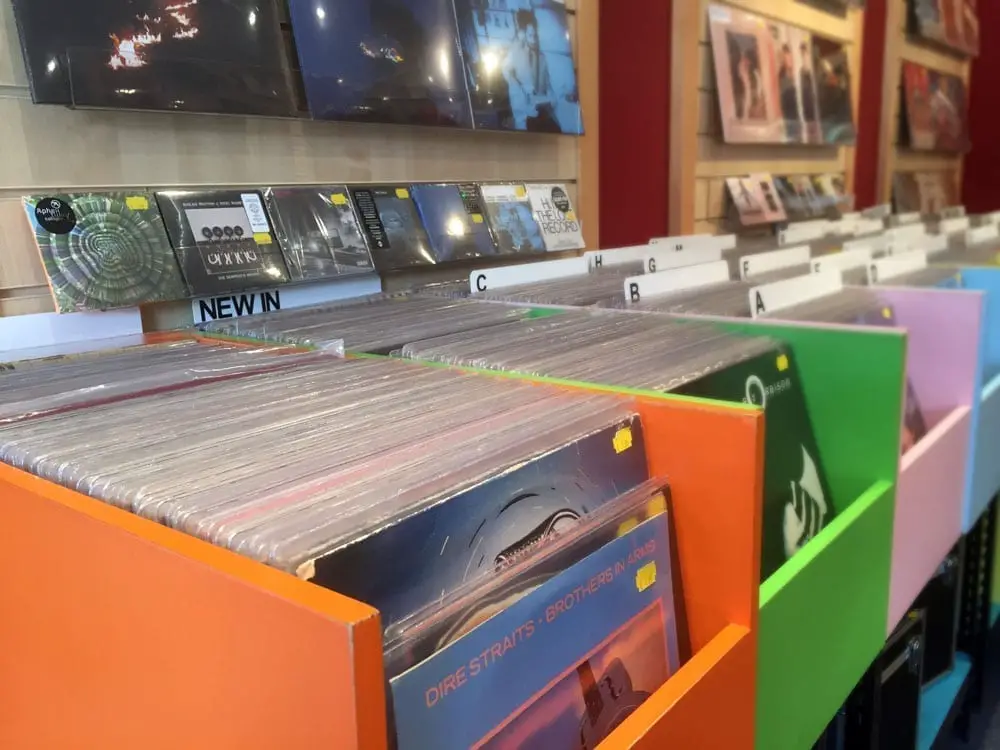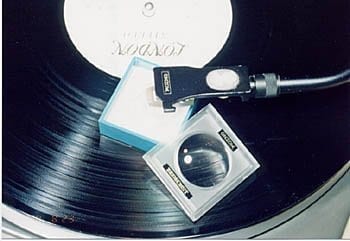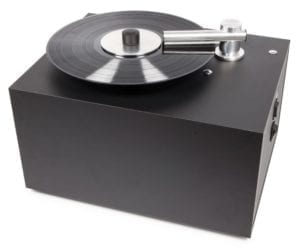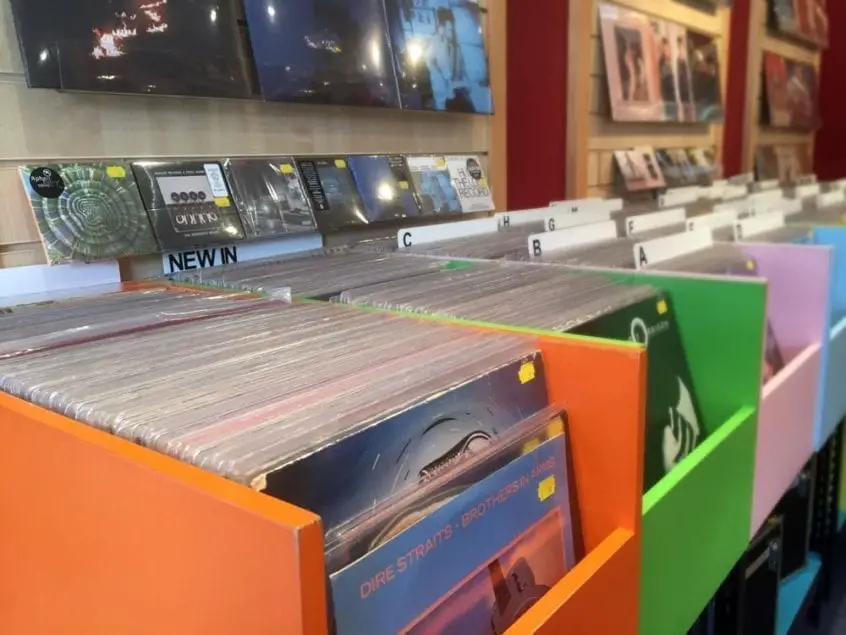In 2015, sales of vinyl records grew for the tenth consecutive year, and while millions of music fans are rediscovering the joy of music on wax, they’re also learning how maintenance comes with the territory. As we’ve already established in our first post about vinyl record care – great sounding records require care and attention. In this second edition, we’ll cover plenty more methods for keeping your records clean and in fantastic shape.

Battling Dust for Cleaner Records
Last time, we established the importance of clean records for great sound. We covered the basics of record storage and cleaning. Today, we’ll cover some more advanced tools you should consider to help simplify the job.
Zerostat 3 Anti-Static Gun
Despite looking like an over-priced children’s toy, the Zerostat Anti-Static gun is highly effective, and a must-have tool in any record collector’s arsenal.
Static charge is an audiophile’s worst enemy; it can build up slowly over time, and will attract every particle of dirt in the immediate proximity to the surface of your record. Surprisingly, brand new records are often statically charged right out of the factory – making them difficult to remove safely from the sleeve.
A slow squeeze of the Zerostat “trigger” releases a stream of ions, which removes the built-up static charge on the record surface instantly. This process prevents debris build-up on your record and lowers the risk of packaging damage when opening new records. If your budget doesn’t stretch to an anti-static gun, you can always use record cleaning solution to neutralize static, but this won’t help you with those pesky new record openings, of course.
Onzow Zero Dust Stylus Cleaner
 Conventional stylus brushes work great for removing the build-up of dust and dirt, but there’s always risk you could damage the stylus shank. The Onzow Zero Dust might look a little crazy and space age, but it’s far safer than a brush, and arguably yields better results. It features a specially developed ultra-soft plastic that gently clings to anything it touches. Simply allow your tone arm to drop gently into the lowered position, then carefully press the Zero Dust up towards the stylus and pull away to leave your stylus clean and clear. As a bonus, the Zero Dust doubles up as a magnifier, which is handy for stylus inspection.
Conventional stylus brushes work great for removing the build-up of dust and dirt, but there’s always risk you could damage the stylus shank. The Onzow Zero Dust might look a little crazy and space age, but it’s far safer than a brush, and arguably yields better results. It features a specially developed ultra-soft plastic that gently clings to anything it touches. Simply allow your tone arm to drop gently into the lowered position, then carefully press the Zero Dust up towards the stylus and pull away to leave your stylus clean and clear. As a bonus, the Zero Dust doubles up as a magnifier, which is handy for stylus inspection.
Cork Turntable Mat
Another way you can significantly reduce the build up of static and dust is by ditching your standard felt turntable mat for cork. The standard felt mat supplied with most turntables collects dust and dirt through static charge, which in turn is transferred to your records causing undesirable pops and click. A cork mat is less prone to static and also improves sound quality by enhancing contact between the record surface and turntable platter. I use the Project one.
 Project Vinyl Cleaner VC-S
Project Vinyl Cleaner VC-S
Record cleaning machines are typically very expensive – making them prohibitively expensive for most collectors. However, the fact remains, vacuum record cleaners are the most efficient way to thoroughly clean vinyl because the dirt and dust as physically extracted from the surface. The Project Vinyl Cleaner will set you back a pretty penny, but if you can spare the money (and space in your home), the results are impressive. You’ll also save a lot of time and effort when batch cleaning large collections.
The Importance of a Great Turntable
Amazingly, record players were one of Amazon’s biggest sellers last Christmas, which would certainly suggest the Vinyl trend isn’t going anywhere fast. The problem is, most of these turntables were cheap, low-quality offerings for under $100; and while some of these devices have their place as throwback nostalgia items, they’re certainly not conducive to great sounding, well looked after records.
In my experience, cheap record players are poorly set up, come with cheap sapphire styli, and sound poor. At the end-of-the-day, we’re talking about a play-back mechanism that works on a microscopic level; each groove is less than a human hair wide, and any misplacement could play havoc with your precious grooves over time. The long and short of it is this: your turntable needs to be meticulously engineered, and I don’t know about you, but I don’t think $100 is going to cut it.
So does that mean a low-budget can’t yield good results for low record wear? Absolutely not…
I’ll level with you; I don’t have a big budget to spend on my vinyl hobby. At first, I started out with a cheap Marantz all-in-one system with the pre-amp included. It was a nightmare; the thing skipped – even when playing new records – and some of my earlier purchases suffered permanent damage as a result of playing them on this system. I quickly realised that while I had to keep within a reasonable budget, there was a limit. I swiftly returned the first hunk-of-junk for something less feature rich, but with all the basics just right. If you’re playing your records on a cheap setup, it won’t matter if you follow all the advice in part one and two of this guide, your records (and sound quality) will ultimately suffer.
Check out our list of the best budget turntables with low record wear.
Taking Set-up to the Next Level
Stylus Tracking Force Gauge
We covered cartridge alignment in part 1 — establishing how poor setup can damage grooves — but we haven’t yet covered tracking force. Similarly to alignment, incorrect tracking force causes mistracking, which results in excessive record and tip wear — not to mention poor sound reproduction. It’s important to follow the manufacturers instructions closely when setting up the counterweight for your cartridge/turntable combination. If you’ve followed the instructions carefully, you should be able to get pretty close to the optimum tracking force; however, you can’t know for sure unless you measure using a stylus tracking force gauge. Better safe than sorry.
The Bottom Line
With vinyl records, it’s important to remember that anything coming into contact with your records will affect playback and ultimately the longevity of your precious wax. Take the time to keep your records stored correctly and clean; combine these with a precisely tuned turntable, and they’ll ultimately reward you with year-after-year of beautiful sounding music. In some ways, if us vinyl geeks are honest with ourselves, there’s something rewarding about the fussiness of vinyl. The process itself is somehow therapeutic, and in many ways, that’s half the joy of it all.




Hey there! Thanks for great posts, I really love to read them. I’m having questions about the proper way of storing my vinyl records in a shelf. I really would like to read a post about that. I don’t know if I should keep the records perfectly upright or if they can lean a little. How much is too much leaning? All that… I’m only sure not keep them stacked in a pile. Thank tyou!
Hey Niko, no problem – I’m glad they’ve been useful. I’ll try an put a piece together on Vinyl record storage at some point. In the meantime, I would try and keep them as upright as possible, and avoid too many records leaning against each other in a pile. So long as there’s no excessive weight you should be fine.
I use cube based record storage units, like this one from IKEA: http://amzn.to/1rbNQpc
Because there are multiple compartments, it limits the weight of each leaning stack.
I hope this helps and thanks for reading 🙂
Hi Niko, I’m pleased to let you know, I now have a post on vinyl record storage. I hope you find it useful: http://www.soundmattersblog.com/store-vinyl-record-collection/
[…] Edit: Check out part 2 of this article for further tips on vinyl record care and maintenance. […]